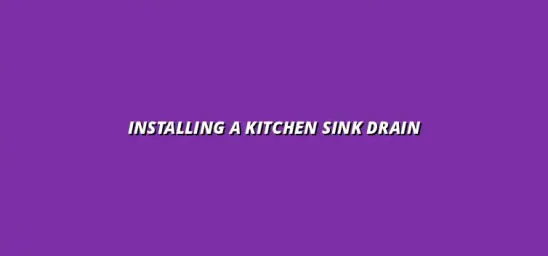
Install Your Kitchen Faucet Easily
Understanding the Basics of Kitchen Faucet Installation
Installing a kitchen faucet might sound intimidating, but once you understand the basics, it can be a straightforward project. Whether you're replacing an old faucet or installing a new one, knowing the components involved is essential. This guide will help you become familiar with the different types of kitchen faucets and what tools you need to get started.
Before diving into the installation process, it's useful to know that kitchen faucets come in various styles and functionalities. From pull-down sprayers to traditional designs, each type offers unique features tailored to different needs. Understanding these options will help you choose the right faucet for your kitchen and ensure a successful installation. If you encounter any issues with your kitchen sink later on, you can find helpful advice on repairing a leaky kitchen sink.
Introduction to Kitchen Faucets and Their Components
A kitchen faucet is made up of several key components that work together to deliver water efficiently. These include the spout, handle, and the cartridges or valves inside that control water flow and temperature. Knowing how these parts function will simplify your installation process.
Additionally, you'll want to familiarize yourself with other important elements such as the mounting hardware, which secures the faucet to the sink, and the aerator, located at the tip of the spout. Understanding these components can help troubleshoot any issues that might arise later. Regular plumbing maintenance is also key to preventing bigger problems.
Types of Kitchen Faucets and Their Features
Choosing the right faucet involves understanding the various types available. Here are a few popular options:
- Single-Handle Faucets: Easy to use and great for quick adjustments.
- Double-Handle Faucets: Provide better control over hot and cold water.
- Pull-Down Faucets: Offer flexibility for cleaning and rinsing.
- Pull-Out Faucets: Similar to pull-downs but with a detachable sprayer.
- Pre-Rinse Faucets: Ideal for heavy-duty tasks, often found in commercial kitchens.
Each of these faucet types comes with its unique features that can enhance your kitchen experience. When selecting a faucet, consider factors such as your cooking style, sink depth, and overall kitchen aesthetics. For example, if you often have blockages, learn how to prevent kitchen sink blockages.
Essential Tools for Installing a Kitchen Faucet
Having the right tools on hand can make your faucet installation much smoother. Here's a list of essential tools you'll need:
- Adjustable Wrench: For tightening and loosening nuts and fittings.
- Screwdriver Set: Both flat-head and Phillips screwdrivers are useful.
- Plumber’s Tape: Helps create a watertight seal on threaded connections.
- Bucket or Basin: To catch any water that may spill during the process.
- Cleaning Cloth: For wiping down surfaces and cleaning as you work.
With these tools ready, you'll be well-equipped to tackle the installation of your new kitchen faucet with confidence! If you need help with other plumbing issues, consider checking out this guide on how to fix a leaky faucet.
The Step-by-Step Process for Installing a Kitchen Faucet
Now that we've covered the basics, it’s time to dive into the step-by-step process for installing your kitchen faucet. Following a clear method will ensure that the installation is seamless and efficient. Let's get started!
Remember, preparation is key! Before you begin, ensure that you have all the necessary tools and materials at hand. This preparation will make the process smoother and faster. If you're dealing with a clogged sink, you can find some quick ways to unblock a sink.
Addressing Common Questions About Kitchen Faucet Installation
When it comes to installing a new kitchen faucet, I know that having the right information can make a big difference! There are several factors to consider to ensure you choose a model that not only fits your style but also works well with your kitchen's plumbing. Let’s explore some key considerations that can help you make an informed decision.
What to Consider When Choosing a New Kitchen Faucet
Choosing the right kitchen faucet can be a fun but sometimes overwhelming process. With so many options available, it’s essential to narrow down what features are important for your kitchen. Here are some factors to think about:
- Style: Decide if you want a traditional, modern, or farmhouse style faucet.
- Finish: Consider a finish that complements your other kitchen fixtures, such as chrome, stainless steel, or oil-rubbed bronze.
- Height: Ensure the faucet height fits well with your kitchen setup, especially if you have a deep sink.
- Spray Options: Think about whether you want a pull-down sprayer, a side sprayer, or a standard faucet.
Understanding Different Faucet Styles and Finishes
It’s important to understand that various styles and finishes come with their own characteristics and benefits. For instance, some finishes can resist fingerprints and water spots, while others might require more maintenance.
Here are some popular faucet styles to consider:
- Single-handle faucets: Easy to operate with one hand and ideal for multitasking!
- Double-handle faucets: Offer precise temperature control and a classic look.
- Pull-down/pull-out faucets: Great for rinsing veggies and cleaning the sink!
Compatibility with Existing Plumbing Systems
Before you get too excited about a new faucet, check its compatibility with your current plumbing system. Most faucets have standard base sizes, but it’s crucial to ensure they match your sink and plumbing connections. Remember that annual water heater inspections are also important for overall plumbing health.
To ensure compatibility, consider:
- Mounting holes: Verify how many holes your sink has and choose a faucet that fits.
- Water supply lines: Make sure the faucet’s connections match your existing supply lines.
- Height requirements: Ensure there’s enough clearance for the faucet to operate without hitting the backsplash.
Common Mistakes to Avoid During Installation
Like any home improvement project, there are common pitfalls to watch out for when installing a kitchen faucet. Recognizing these mistakes beforehand can save you time and frustration down the road!
Overlooking Key Safety Precautions
First and foremost, safety is crucial during any DIY project. It's easy to get caught up in the excitement of a new faucet, but some precautions shouldn't be ignored:
- Wear protective gear: Use gloves and goggles to protect yourself from sharp tools and debris.
- Check for leaks: Before finalizing your installation, always check all connections for leaks.
- Secure tools: Keep your workspace organized to avoid accidents with tools and parts.
Neglecting to Read Manufacturer Instructions
Many people skip reading the installation manual, thinking they know how to install the faucet. However, each model can have specific requirements and steps!
To avoid this mistake, remember to:
- Read the manual thoroughly: Understand all the steps before you start.
- Follow the guidelines: Adhere to the recommended installation process for best results.
- Take notes: Jot down any important details that may help you during the installation.
Final Thoughts and Maintenance Tips for Kitchen Faucets
Once your new kitchen faucet is installed, it’s essential to keep it well-maintained for longevity! A little bit of effort can go a long way in ensuring that your faucet remains functional and looks great over time. For more extensive plumbing issues, you might need to contact a local professional. For example, if you live in Billesley, Birmingham, you can look for a plumber in Billesley, Birmingham.
Maintaining Your Kitchen Faucet for Longevity
Regular maintenance can help prevent issues and extend the life of your faucet. Here are some simple yet effective care tips:
- Regular cleaning: Wipe down the faucet with a soft cloth to remove dirt and grime.
- Check for leaks: Periodically inspect for leaks so you can address them quickly.
- Replace washers: If you notice dripping, replacing washers can often fix the problem.
Routine Care and Cleaning Techniques
Using the right cleaning products is key to maintaining your faucet's appearance. Avoid harsh chemicals that can damage the finish. Instead, opt for:
- Mild soap and water: Perfect for a gentle cleaning.
- Vinegar solution: Great for mineral buildup!
- Soft cloth or sponge: Ideal for scrubbing without scratching.
When to Call a Professional for Repairs
Sometimes, issues can arise that are beyond a simple fix. If you experience persistent leaks, strange noises, or complicated plumbing issues, it may be time to call in a professional. Remember proactive maintenance can help avoid bigger problems, and a plumbing maintenance checklist can be very helpful.
Here are signs it's best to seek help:
- Unresolved leaks: If leaks persist after repairs, consider a professional inspection.
- Low water pressure: If you notice a drop in pressure, it could be a plumbing issue.
- Complex problems: Don't hesitate to call a plumber for complicated plumbing issues!
Encouraging Reader Engagement and Feedback
I love hearing from readers about their experiences with kitchen faucet installation! Engaging with you can lead to even more helpful tips and insights that benefit everyone.
Inviting Questions and Comments About the Installation Process
If you have any questions about the installation process or need clarification on certain steps, please feel free to ask. Your inquiries can help others who might be facing similar challenges!
Sharing Personal Experiences and Tips in the Comments Section
Don't hesitate to share your own experiences with faucet installation! Whether it’s a tip you found useful or a funny mishap, your stories are valuable and can help create a supportive community.





Fixing a Backed-Up Kitchen Sink
Prepare Your Plumbing for Weather
Installing a Kitchen Sink Drain
When to Replace Plumbing Fixtures
Fixing a Jammed Garbage Disposal